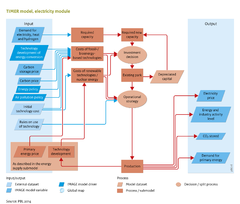Energy conversion: Difference between revisions
Jump to navigation
Jump to search
No edit summary |
No edit summary |
||
| Line 1: | Line 1: | ||
{{ComponentTemplate2 | {{ComponentTemplate2 | ||
|Status=Publishable | |Status=Publishable | ||
|MainComponent=Energy supply and demand | |||
|Application=Resource Efficiency | |Application=Resource Efficiency | ||
|IMAGEComponent=Energy supply and demand; Energy demand; Energy supply; Land use allocation; Climate policy; Drivers | |IMAGEComponent=Energy supply and demand; Energy demand; Energy supply; Land use allocation; Climate policy; Drivers | ||
| Line 12: | Line 13: | ||
|CaptionText=Flow diagram Elecricity Model | |CaptionText=Flow diagram Elecricity Model | ||
|AltText=Flow diagram Elecricity Model | |AltText=Flow diagram Elecricity Model | ||
|FrameworkElementType=model component | |||
}} | }} | ||
Revision as of 09:31, 17 June 2013
Parts of Energy conversion
| Component is implemented in: |
|
| Related IMAGE components |
| Projects/Applications |
| Models/Databases |
| Key publications |
Key policy issues
- What is the potential role of energy conversion sector, particularly in power production, in achieving a more sustainable energy system?
- What are the potential roles of individual technologies, such as carbon capture and storage (CCS), nuclear power, hydrogen and renewable energy?
Introduction
"model component" is not in the list (driver component, pressure component, interaction component, state component, impact component, response component) of allowed values for the "FrameworkElementType" property.
